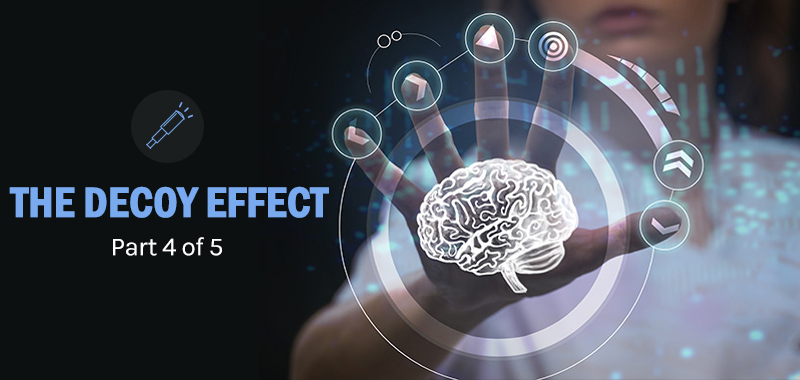Welcome to part 4 of our 5 part series on psychology as applied to marketing outreach. In the 3rd part, we talked about priming, the subtle way in which word choice and topic focus subconsciously impacts how people perceive a situation and respond to it, accordingly.
Today, we’re going to talk about the decoy effect, a bizarre cognitive bias that causes us to change how we make decisions when a clearly inferior option is introduced.
This is something that a lot of conversion rate optimizers have already been caught on to, but I believe it has important implications for outreach too.
Before we continue I want to be clear, and not for the last time, that this tactic is probably the most dangerous of the five effects that we’ve been discussing in this series. It’s potentially powerful, but also very susceptible to cynical manipulation, which is never a good long-term business strategy. Please keep that in mind.
Let’s talk about how it works.
How It Works
In a surprising psychological experiment, Joel Huber and his colleagues at Duke University explored this effect and arrived at some very counterintuitive results, revealing the biased and odd way people make decisions.
One group of participants was given a choice between a 3 star restaurant and a 5 star restaurant, with one catch: the 5 star restaurant was farther away.
How did the participants respond? With mixed results. The trade-off between convenience and quality was a hard issue to navigate.
But, things got weird when Huber and his colleagues threw in a third choice, a 4 star restaurant that was even farther away than the 5 star.
Suddenly, the choice was clear. Far more participants chose to go for the 5 star restaurant.
It worked the other way too. When Huber introduced a 2 star restaurant that was located halfway between the 3 star and the 5 star, all of a sudden people overwhelmingly chose the 3 star.
These bizarre results mean that throwing in an option that no rational person would choose (a decoy) can completely change what decision people will make.
When one clearly inferior option is introduced, we’re more likely to choose the option that it clearly loses to, as opposed to the option with some benefits and some trade-offs.
National Geographic Channel even ran their own for-infotainment version of this experiment, only this time with popcorn. By introducing a “middle sized” popcorn that was clearly an inferior deal to the “large,” people were more likely to choose the large, even though they were more likely to choose the small if the middle sized option didn’t exist. Since this option worked with real money, it’s an especially strong example of the effect.
Thoughts On Applications For Outreach
Okay, but how does this apply to outreach? What am I suggesting is that you should offer a terrible idea for a guest post in order to make other options seem more appealing?
Well, no.
But here’s the thing to keep in mind. People’s default response to an unsolicited email is nothing at all. “No response” is our “small popcorn” or our “3 star restaurant.”
Is it possible to use the decoy effect to get a response to an email? I believe that it is, but we need to be careful here, as well as respectful. So before diving into some concrete examples, I want to give this tactic a bit more thought.
I believe that you can take advantage of the decoy effect by asking for one of two things from the recipient: merely responding to your email about something, and asking for something a bit more demanding.
Asking for something a bit more demanding here is, of course, the “decoy.” However, unlike the decoys used in the examples above, I believe that this “decoy” should still be:
- An option that is mutually beneficial
- An option that you are entirely willing to follow through on
I’d also stress that you should make it clear that this option is above and beyond the call of duty and that you aren’t expecting a yes from them on it.
(Incidentally, a meta-analysis of 42 separate studies concludes that when you remind people that they are free not to accept an offer, they are more likely to accept the offer, so there’s no downside to reminding people of their own free will.)
By including an obviously more demanding option that requires more investment from the recipient, the much smaller commitment looks more reasonable, and people may be more likely to respond positively to it.
Out of all of the psychological effects discussed in this series, I want to stress again that this one is probably the most dangerous or let me say the trickiest. It’s susceptible to cynical manipulation, which I don’t believe ever pays off in the long run, so be careful to use it with the best of intentions, and do not abuse the technique.
Some Examples
Here’s an example of a type of email that has worked for me:
Subject: Hi [name], we would like to feature you in our [brand] Spotlight
Body:
Hi [name], we came across your post: [title] this week and it led us down quite the rabbit hole with your blog. Every month we like to feature somebody we consider “must follow” in the [topic] industry, and if you’re interested we would like it to be you. If it’s okay with you, we would like to put a blog post together, as well as send you a few short questions for inclusion in the post. Here is an example of the end result: [link]
Are you interested?
Some of our [brand] Spotlight members also like to join us for a livestream video/podcast like this one: [link]
This is optional, but if you’re interested let us know.
Thanks,
[name]
Let’s talk about why this works.
Our “decoy” is the livestream video/podcast. Of course, by now I think you understand why I put “decoy” in quotation marks. It’s difficult to imagine a scenario where a true decoy would play out well in an outreach email without seeming manipulative. A true decoy is clearly an inferior option. In this case, the option of joining the podcast isn’t really inferior, it’s merely more demanding.
I believe that a similar effect is at play here, however. Introducing the option of a full podcast interview makes “a few short questions for inclusion in the post” seem much less demanding. I’d like to believe that there are enough other factors at play here that it’s not really necessary, but I do believe it helps.
Also note that our other effects are in full swing here. There’s a whole lot of reciprocity at play; we’re essentially offering them free press and asking for very little in return. We haven’t mentioned them linking to the post or promoting it, but we can expect that to be an easy bridge to cross if they agree on answering a few short questions.
Our anchoring is also very balanced. The majority of the email is in line with the expectations set by the subject line, and the fact that the podcast is optional means that it won’t really change that.
There is kindness too “priming” in that. Featuring them on the blog is essentially a gift. We have also established a context for the email, priming them to evaluate the email as an opportunity rather than something that seems like begging or from coming a job applicant, eventually seeming desperate and not on the same page.
I want to call attention to how natural the “decoy” is, in this email. There is nothing out of the blue or particularly odd about asking somebody that you want to feature in a blog post if they would also be interested in a podcast interview. Likewise, it is an option we fully intend to follow through on, if they are interested in it. A podcast is a legitimately beneficial opportunity for the both of us, but we recognize that it’s demanding enough not to make it the only option, and thus to treat it as our “decoy,” despite the fact that we’d be very happy if they agreed onto it.
Fortunately, for all of us, this psychological approach hasn’t really caught on enough, for us to see it get abused in our inbound mail. But I feel it would be irresponsible to share this approach without discussing an example of how it could be handled badly. So, before I let you go off and use this tactic, I’d like to share a hypothetical example.
Subject: Hi [name], are you interested in a guest post about [topic]?
Body:
Hello [name]. We came across your post about [topic] and found it interesting. We noticed that you haven’t written anything more specifically about [niche]. If you’re interested, we would like to write up a guest post on the topic for you. The basic outline would be as follows:
[outline]
Let us know if you would be interested.
Or, if you’re interested, please link to our post here: [link]
Thanks,
[name]
I cringed writing that.
Alright, so what went wrong here? Most of the email is pretty great. However, it’s not the perfect email, to send to somebody if you’re interested in writing a guest post for them, but it’s difficult to write a good one without a specific target in mind.
But then we employ our failed “decoy.”
If we set everything else aside and just think in terms of the decoy effect, it would be easy to convince ourselves that an email like this could work. After all, we’ve given them the choice between an appealing guest post opportunity and the clearly irrational choice of just linking to us with nothing in it for them. Of course they’re going to choose the guest post! (I hope the sarcasm is self-evident.)
In reality, this isn’t going to work. I hope your gut was already telling you that, but it’s worth devoting some discussion to the psychology of why this wouldn’t work when the decoy effect apparently does.
Anchoring is largely responsible for this reaction. The “option” of just linking to us is so much more terrible and unrelated to the tone set up until that point, that it sticks out like a sore thumb and taints the entire email. It’s also strong enough on its own to change the way that the email primes our recipient for future behavior. It completely changes the context of the email, making it seem like we’re no longer interested in collaborating, but only in doing whatever it takes to get a link.
Probably most important, though, it ruins any sense of reciprocity. Recall from the first post in this series that reciprocity is driven by gratitude and familiarity. These emotional factors far outweigh any more financial cost-benefit analysis that might be made. The line where we just ask them to link to us, even if we state that it’s optional, eliminates any reason for our recipient to feel a sense of gratitude.
To reiterate, the best way to deploy the decoy effect in your outreach is to use a “decoy” that actually fits naturally with your main request. It should actually be mutually beneficial and make sense to both parties, and something you are willing to follow through on, but is demanding enough to make your primary offer look less daunting in comparison.
If you want to learn more about the psychology of outreach, or couldn’t quite follow some of the references in this post, be sure to check out the earlier installments in this series:
- Part 1: Reciprocity
- Part 2: Anchoring
- Part 3: Priming
6,261 total views, 1 views today

